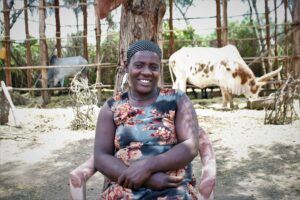Despite the progress, climate, covid, and conflict have significantly slowed the progress. World Food Program estimates that 828 million people go hungry every night. Since 2019, the number of those facing acute food insecurity has soared – from 135 million to 345 million. With rising food insecurity and malnutrition, global solutions are needed for better production, nutrition, environment and life. CDF Canada, through its 4R Nutrient Stewardship Project, has been building sustainable cooperative communities.
As we celebrate Oct 15 and Oct 16 as International Day of Rural Women (Rural Women Cultivating Good Food for All) and World Food Day (theme Leave No One behind). The aim is to highlight the rising challenge of hunger, poverty and malnutrition across the globe and find collective solutions to build a sustainable future.
Read the story of the impact of our projects in Ethiopia and Ghana on how coop communities are building resilient and sustainable communities.

Ayelu Mamo, Minjar Shenkora, Ethiopia
“Since the 4R project has been introduced in our community, I have become a member of the rural commercial women group and have been provided with many business skills training like financial literacy planning, bookkeeping, and saving. Before the training, my weekly saving was not more than 500 Birr. Now, I save 1200 birr in our “Ekub”(a traditional saving group) and 500 at the Saving and Credit Organization. I also bought land in Ararti town (the Capital of the district) for 52,000 Birr to build a residential house,” said Ayelu Mamo, a wife and mother of two, who lives in Engida Eshet village of the Kombolcha community in the Minjar Shenkora district of the Amhara region, Ethiopia.
Read the blog on her learning and savings and how she is turning her life for the better.
In another blog from Ghana. We learn how 4R principles are helping smallholder farmers get better yields.

Kpantin Yaba- CVAEA, Katiejeli| Kpandai District, Ghana
“Before the 4R project, I used to cultivate a two-acre maize field. I planted randomly and mostly did not apply fertilizer because no one was there to help me. The weeding too was inconsistent as it was also labour-intensive for me alone. When it was time for harvesting, I harvested 3-4 bags of maize from the two-acre field. I was content with it thinking it was probably the soil or the inconsistent rainfall. But after I joined the 4R co-operative and participated in the demonstration plot field days, I applied the lessons from there on my same two- acres of land in 2021 – planted in rows, applied fertilizer two weeks after planting by dibbling and burying, and top dressed at six weeks. At harvesting, guess what? I harvested 10 bags of maize from the same two-acre land! So why won’t I double my acreages with my husband and do the right thing?” said Kpantin Yaba, a 43-year-old woman, a mother of four and now a 4R Solution project Community Volunteer Agricultural Extension Agent (CVAEA) from Katiejeli in the Kpandai district, Ghana.